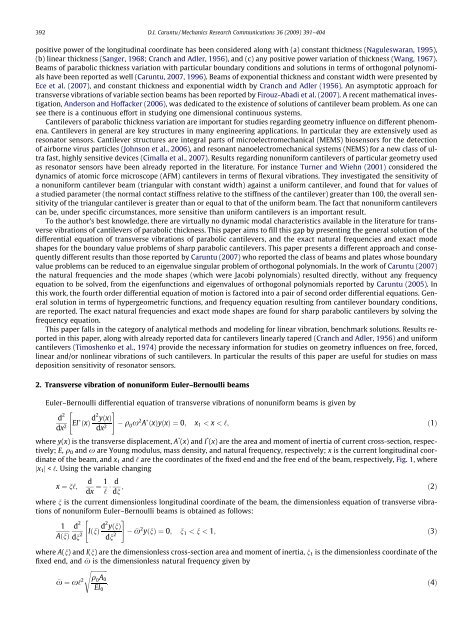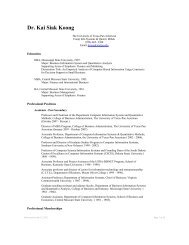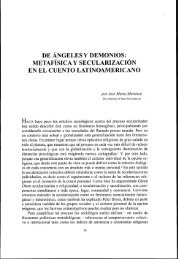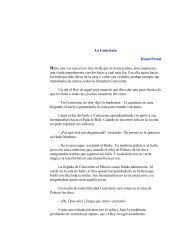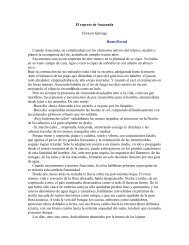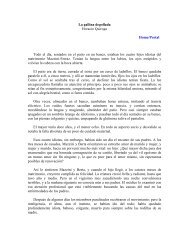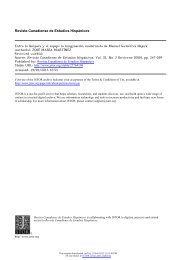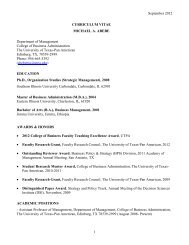Dynamic modal characteristics of transverse vibrations of cantilevers ...
Dynamic modal characteristics of transverse vibrations of cantilevers ...
Dynamic modal characteristics of transverse vibrations of cantilevers ...
You also want an ePaper? Increase the reach of your titles
YUMPU automatically turns print PDFs into web optimized ePapers that Google loves.
392 D.I. Caruntu / Mechanics Research Communications 36 (2009) 391–404<br />
positive power <strong>of</strong> the longitudinal coordinate has been considered along with (a) constant thickness (Naguleswaran, 1995),<br />
(b) linear thickness (Sanger, 1968; Cranch and Adler, 1956), and (c) any positive power variation <strong>of</strong> thickness (Wang, 1967).<br />
Beams <strong>of</strong> parabolic thickness variation with particular boundary conditions and solutions in terms <strong>of</strong> orthogonal polynomials<br />
have been reported as well (Caruntu, 2007, 1996). Beams <strong>of</strong> exponential thickness and constant width were presented by<br />
Ece et al. (2007), and constant thickness and exponential width by Cranch and Adler (1956). An asymptotic approach for<br />
<strong>transverse</strong> <strong>vibrations</strong> <strong>of</strong> variable section beams has been reported by Firouz-Abadi et al. (2007). A recent mathematical investigation,<br />
Anderson and H<strong>of</strong>facker (2006), was dedicated to the existence <strong>of</strong> solutions <strong>of</strong> cantilever beam problem. As one can<br />
see there is a continuous effort in studying one dimensional continuous systems.<br />
Cantilevers <strong>of</strong> parabolic thickness variation are important for studies regarding geometry influence on different phenomena.<br />
Cantilevers in general are key structures in many engineering applications. In particular they are extensively used as<br />
resonator sensors. Cantilever structures are integral parts <strong>of</strong> microelectromechanical (MEMS) biosensors for the detection<br />
<strong>of</strong> airborne virus particles (Johnson et al., 2006), and resonant nanoelectromechanical systems (NEMS) for a new class <strong>of</strong> ultra<br />
fast, highly sensitive devices (Cimalla et al., 2007). Results regarding nonuniform <strong>cantilevers</strong> <strong>of</strong> particular geometry used<br />
as resonator sensors have been already reported in the literature. For instance Turner and Wiehn (2001) considered the<br />
dynamics <strong>of</strong> atomic force microscope (AFM) <strong>cantilevers</strong> in terms <strong>of</strong> flexural <strong>vibrations</strong>. They investigated the sensitivity <strong>of</strong><br />
a nonuniform cantilever beam (triangular with constant width) against a uniform cantilever, and found that for values <strong>of</strong><br />
a studied parameter (the normal contact stiffness relative to the stiffness <strong>of</strong> the cantilever) greater than 100, the overall sensitivity<br />
<strong>of</strong> the triangular cantilever is greater than or equal to that <strong>of</strong> the uniform beam. The fact that nonuniform <strong>cantilevers</strong><br />
can be, under specific circumstances, more sensitive than uniform <strong>cantilevers</strong> is an important result.<br />
To the author’s best knowledge, there are virtually no dynamic <strong>modal</strong> <strong>characteristics</strong> available in the literature for <strong>transverse</strong><br />
<strong>vibrations</strong> <strong>of</strong> <strong>cantilevers</strong> <strong>of</strong> parabolic thickness. This paper aims to fill this gap by presenting the general solution <strong>of</strong> the<br />
differential equation <strong>of</strong> <strong>transverse</strong> <strong>vibrations</strong> <strong>of</strong> parabolic <strong>cantilevers</strong>, and the exact natural frequencies and exact mode<br />
shapes for the boundary value problems <strong>of</strong> sharp parabolic <strong>cantilevers</strong>. This paper presents a different approach and consequently<br />
different results than those reported by Caruntu (2007) who reported the class <strong>of</strong> beams and plates whose boundary<br />
value problems can be reduced to an eigenvalue singular problem <strong>of</strong> orthogonal polynomials. In the work <strong>of</strong> Caruntu (2007)<br />
the natural frequencies and the mode shapes (which were Jacobi polynomials) resulted directly, without any frequency<br />
equation to be solved, from the eigenfunctions and eigenvalues <strong>of</strong> orthogonal polynomials reported by Caruntu (2005). In<br />
this work, the fourth order differential equation <strong>of</strong> motion is factored into a pair <strong>of</strong> second order differential equations. General<br />
solution in terms <strong>of</strong> hypergeometric functions, and frequency equation resulting from cantilever boundary conditions,<br />
are reported. The exact natural frequencies and exact mode shapes are found for sharp parabolic <strong>cantilevers</strong> by solving the<br />
frequency equation.<br />
This paper falls in the category <strong>of</strong> analytical methods and modeling for linear vibration, benchmark solutions. Results reported<br />
in this paper, along with already reported data for <strong>cantilevers</strong> linearly tapered (Cranch and Adler, 1956) and uniform<br />
<strong>cantilevers</strong> (Timoshenko et al., 1974) provide the necessary information for studies on geometry influences on free, forced,<br />
linear and/or nonlinear <strong>vibrations</strong> <strong>of</strong> such <strong>cantilevers</strong>. In particular the results <strong>of</strong> this paper are useful for studies on mass<br />
deposition sensitivity <strong>of</strong> resonator sensors.<br />
2. Transverse vibration <strong>of</strong> nonuniform Euler–Bernoulli beams<br />
Euler–Bernoulli differential equation <strong>of</strong> <strong>transverse</strong> <strong>vibrations</strong> <strong>of</strong> nonuniform beams is given by<br />
d 2<br />
dx2 EI ðxÞ d2yðxÞ dx2 " #<br />
q0x2 A ðxÞyðxÞ ¼0; x1 < x


